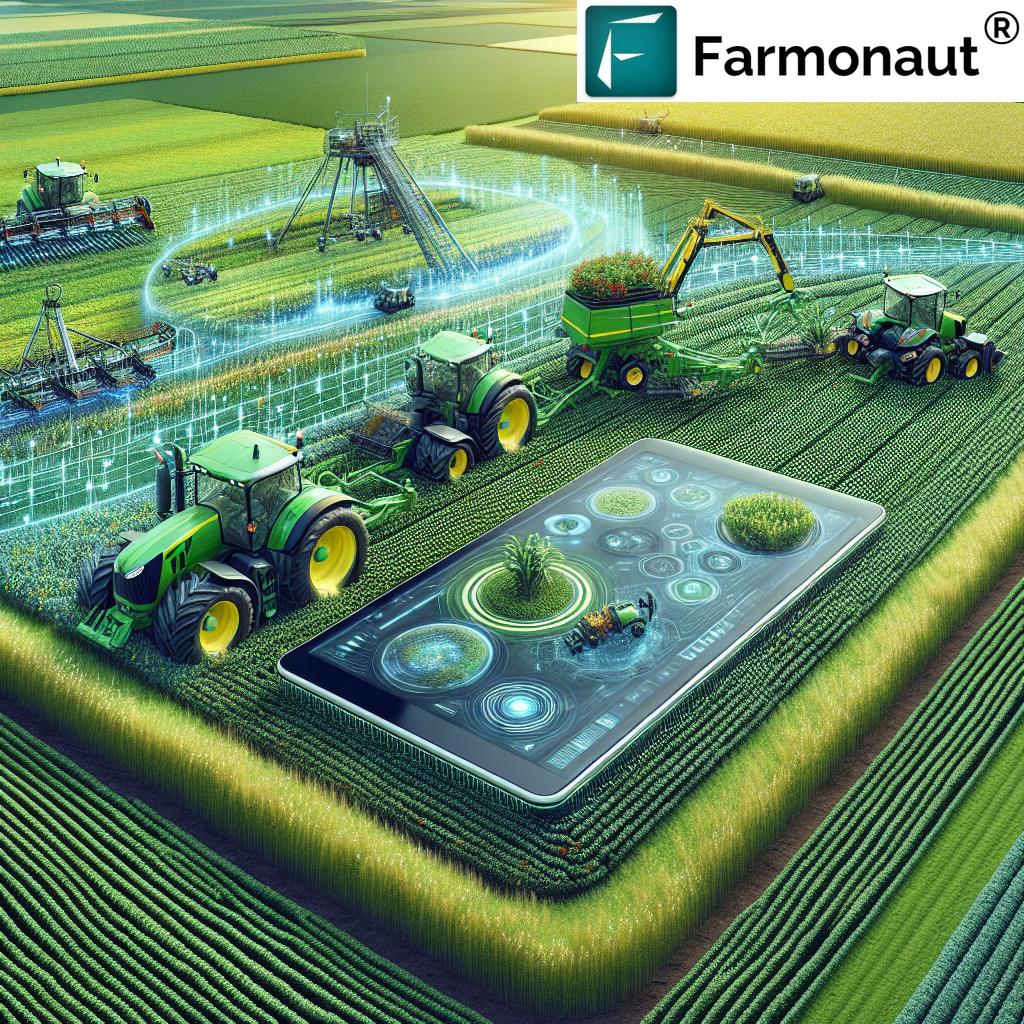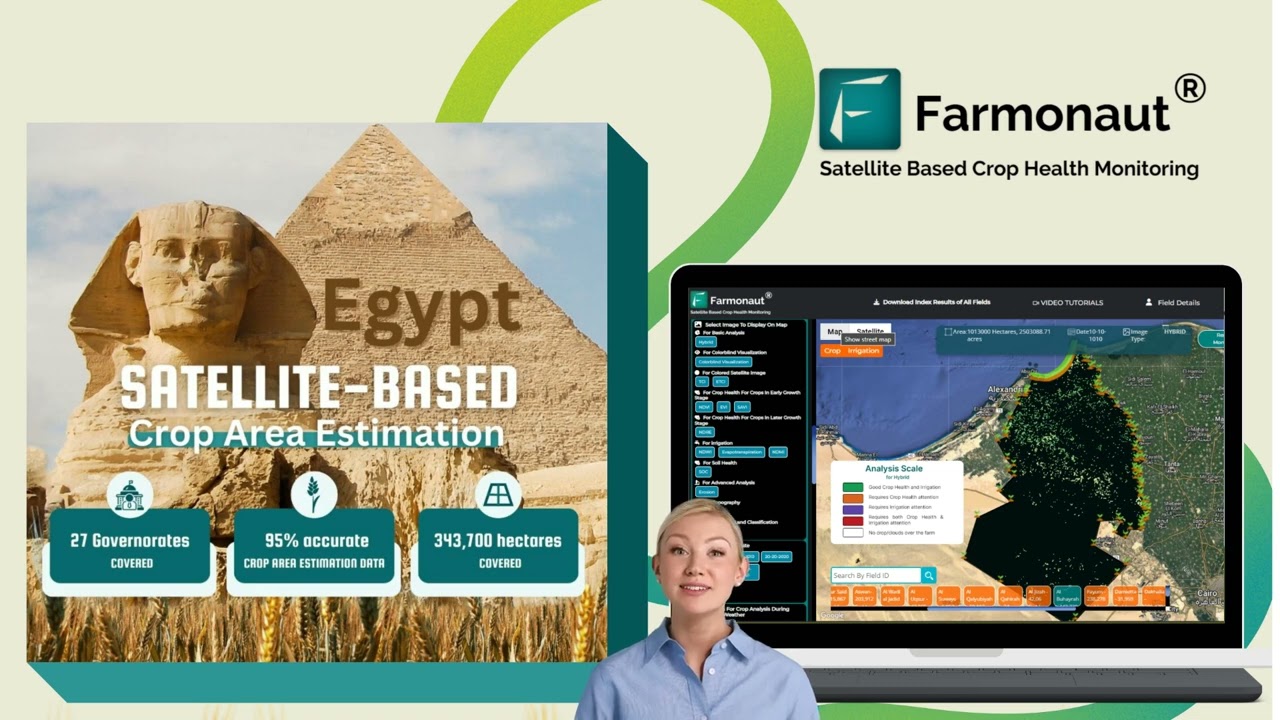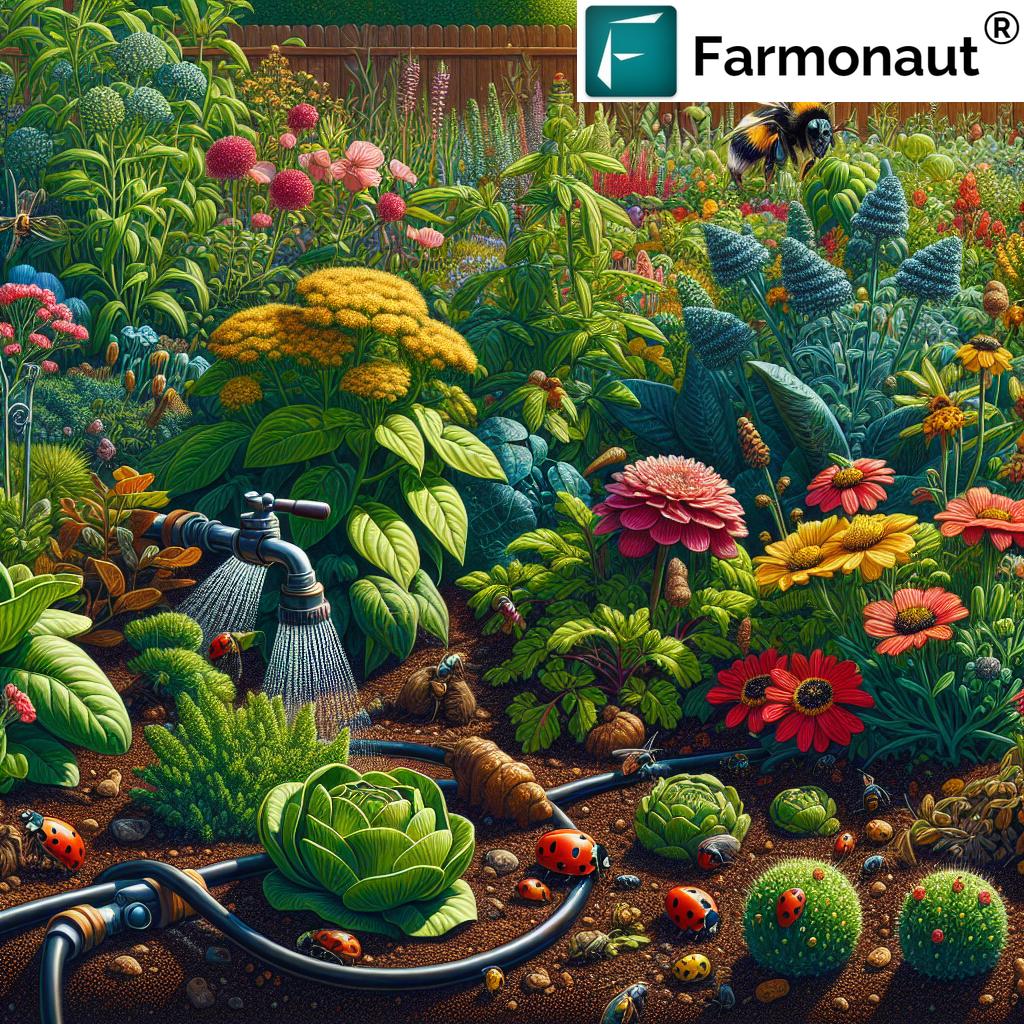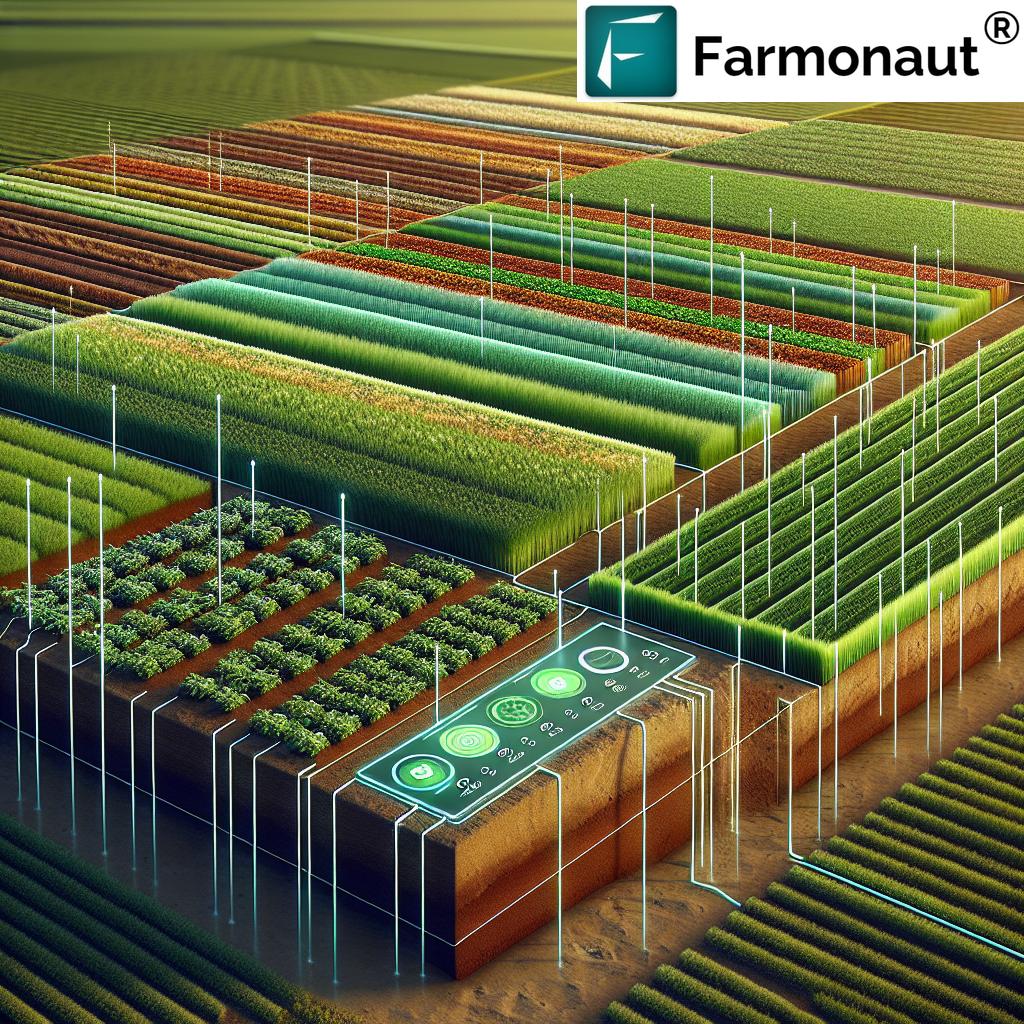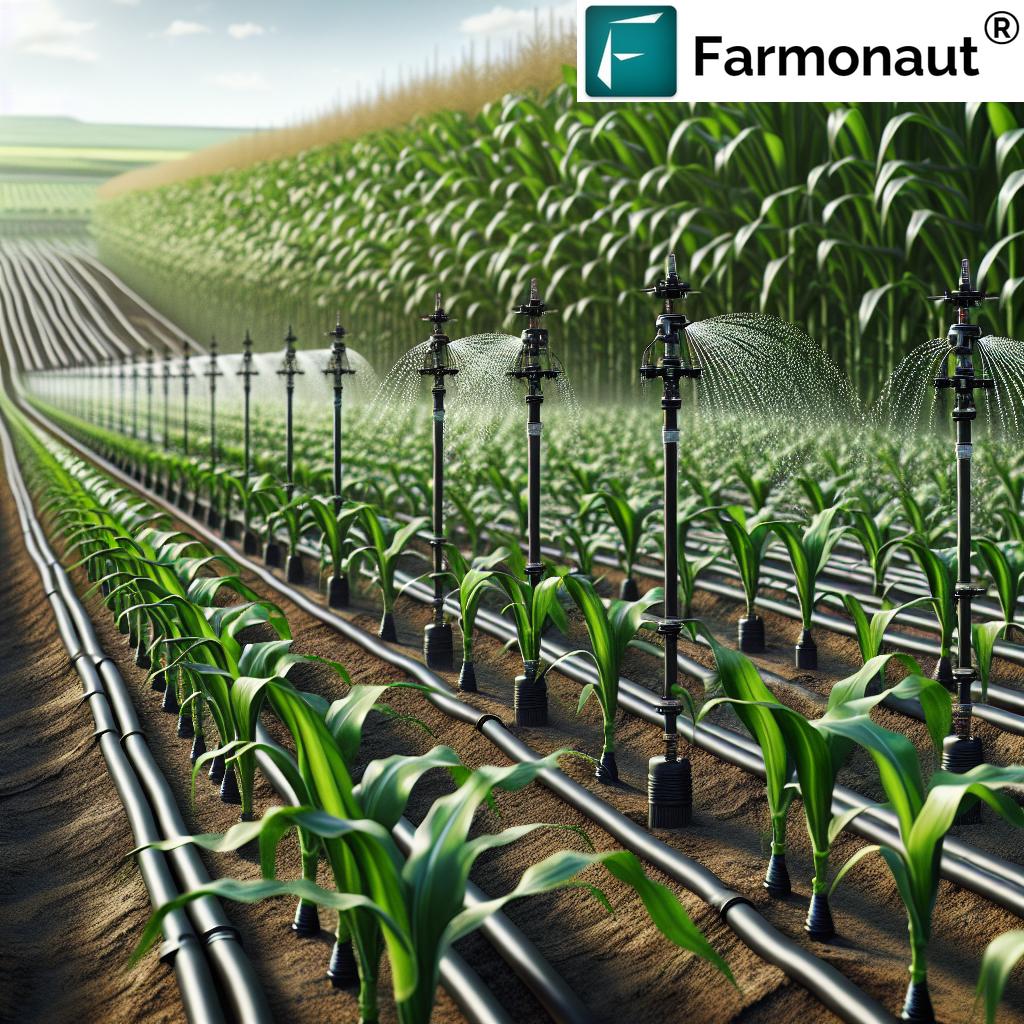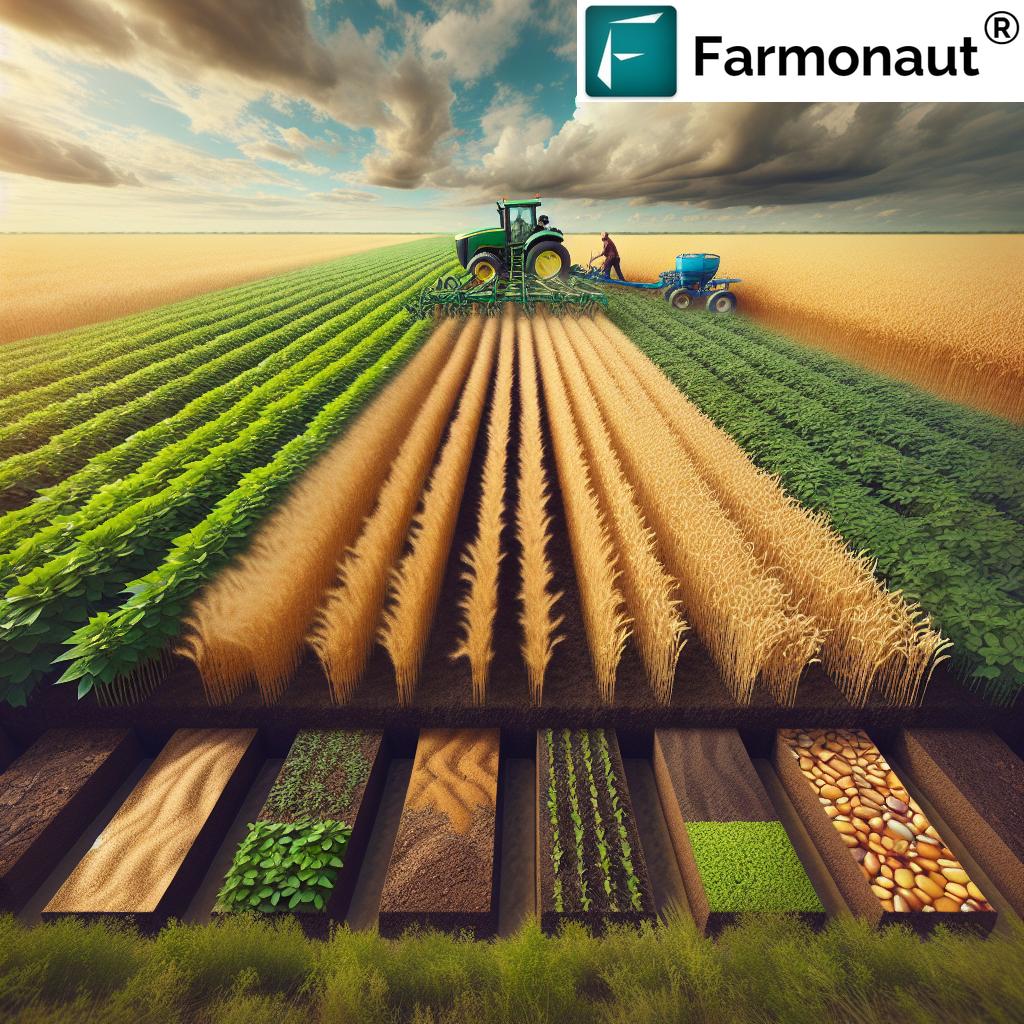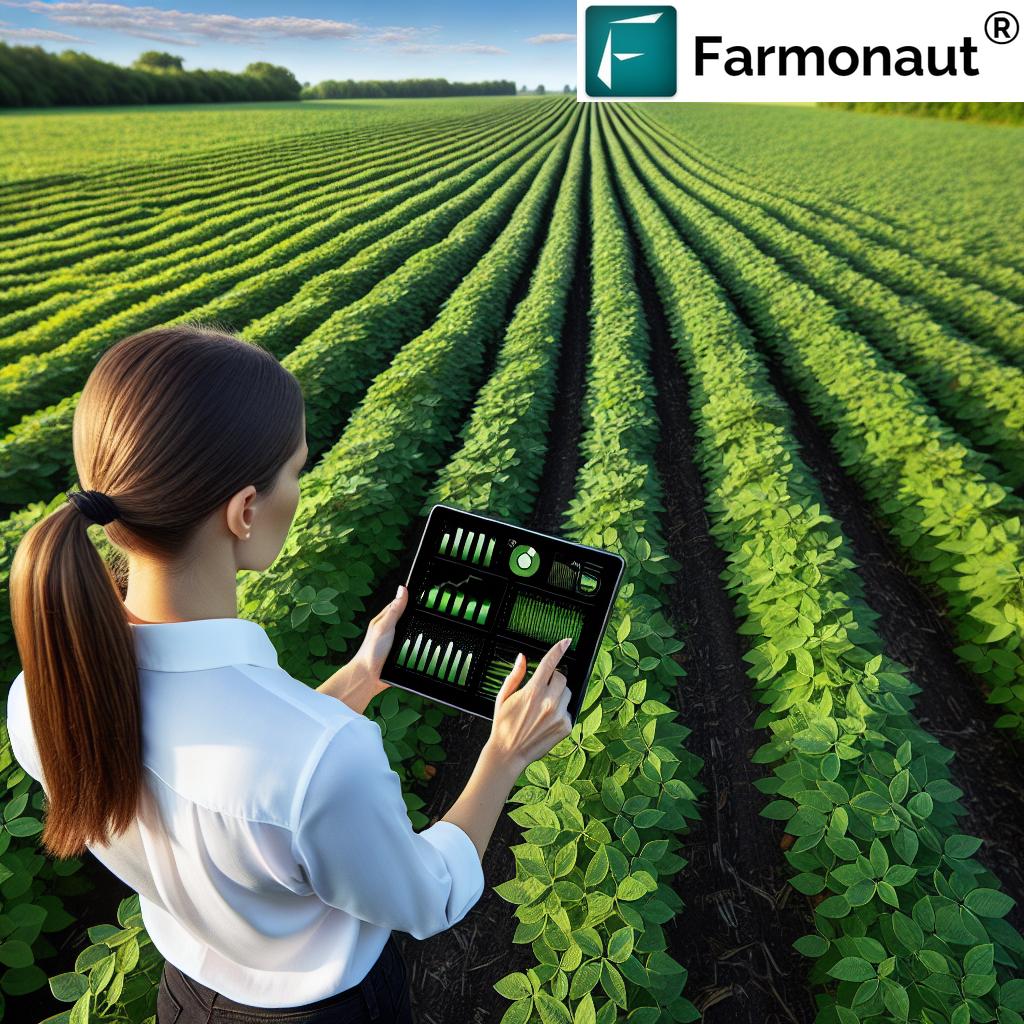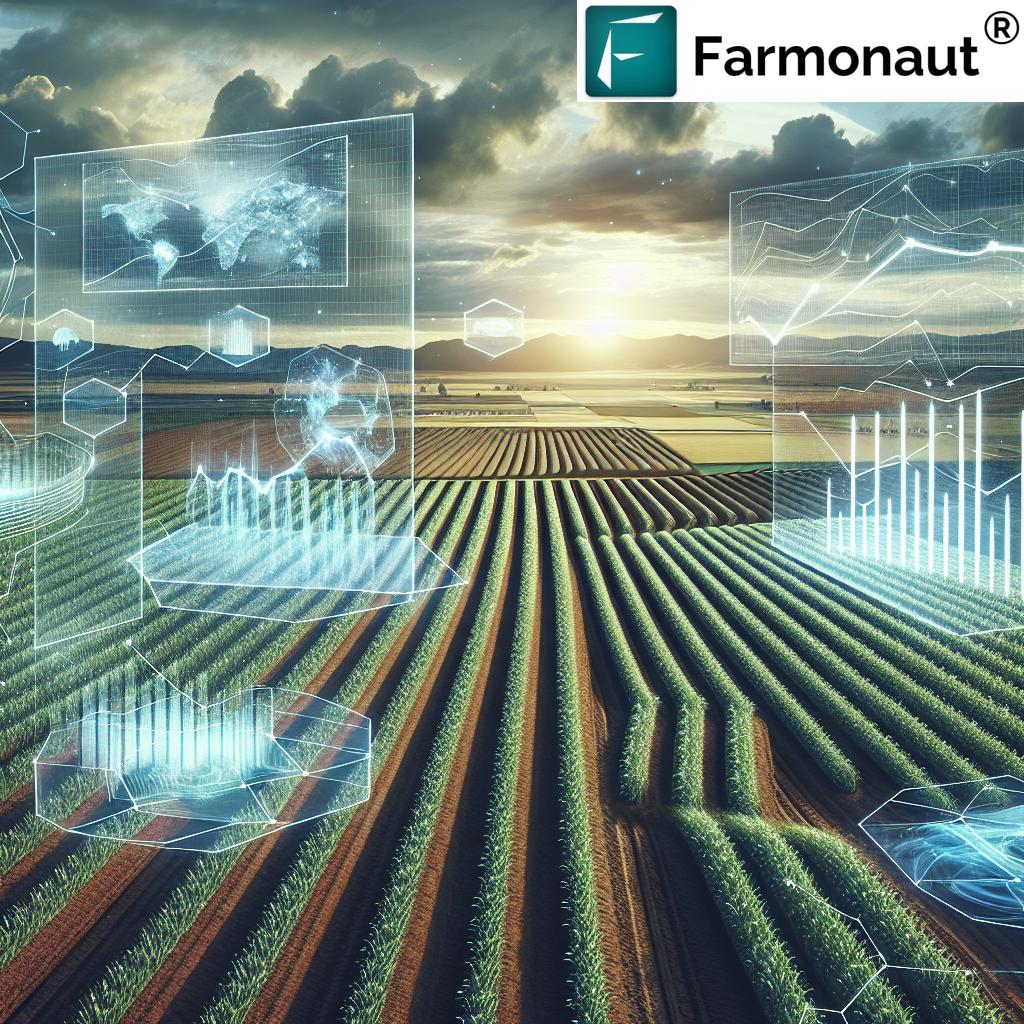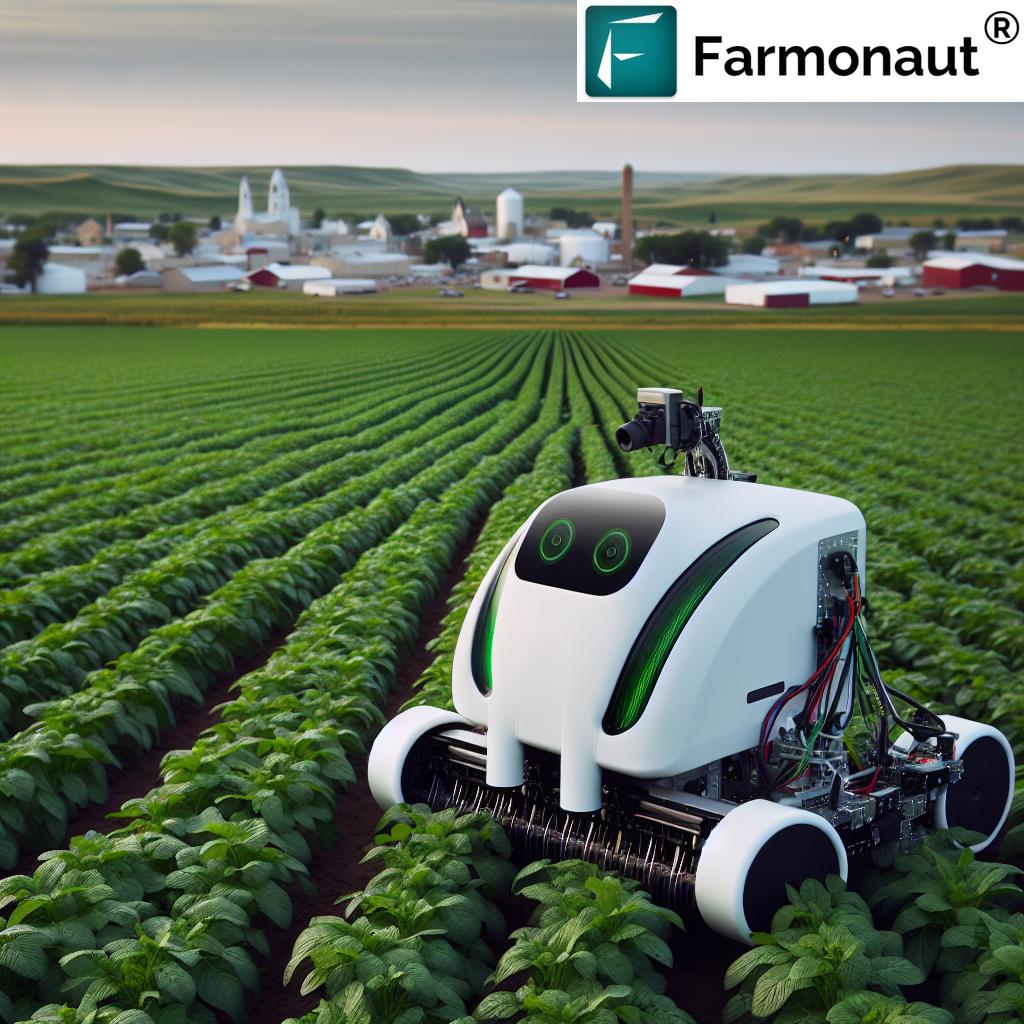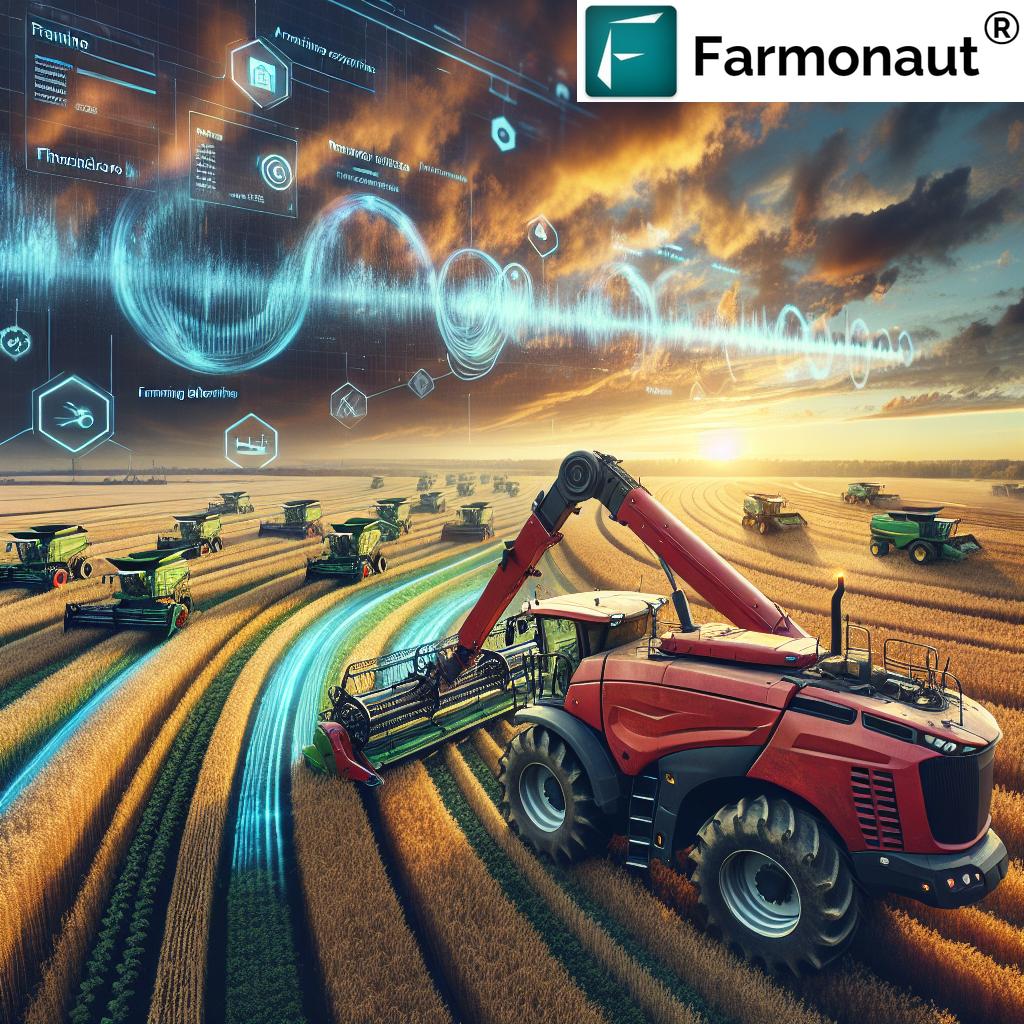7 Innovations in Agriculture Technology You Must See
Table of Contents
- Agriculture Technology Innovations: The Revolution Begins
- 1. Precision Agriculture: Data-Driven Smart Farming Solutions
- 2. Farm Automation and Robotics
- 3. Biotechnology and Nanotechnology in Modern Crop Management
- 4. Data Analytics and AI in Agriculture
- 5. Controlled Environment Agriculture (CEA)
- 6. Blockchain in Agriculture for Transparency
- 7. Sustainable Farming Practices & Climate Adaptation
- Comparison Table of Agriculture Technology Innovations
- Farmonaut: Pioneering Accessible Precision Agriculture
- FAQ: Innovations in Agriculture Technology
- Conclusion
“Precision agriculture can increase crop yields by up to 20% using advanced data analytics and smart farming solutions.”
Agriculture Technology Innovations: The Revolution Begins
The agricultural industry stands at the forefront of a profound transformation. Over the last few years, remarkable innovations have emerged across every domain—from precision agriculture, farm automation and robotics, and data analytics, to biotechnology, climate-resilient practices, and blockchain in agriculture supply chains.
These technological advancements drive greater efficiency, boost crop yields, and enhance sustainability—crucial for a planet grappling with population growth, resource constraints, and climate uncertainty. Today, we’ll explore the seven most important agriculture technology innovations modern farmers must see. We’ll show how precision farming, smart farming solutions, and cutting-edge systems optimize productivity, sustain the environment, and ensure food security for all.
1. Precision Agriculture: Data-Driven Smart Farming Solutions
What Is Precision Agriculture?
Precision agriculture refers to data-driven approaches that integrate sensors, GPS, IoT devices, and farm management platforms to monitor and manage farms at a micro level. By utilizing technology to collect real-time data on soil moisture, nutrient levels, crop health, and environmental factors, farmers can optimize application of water, fertilizers, and pesticides with unparalleled efficiency.
How Precision Agriculture Optimizes Modern Crop Management Techniques
- Real-time soil and crop monitoring allow for targeted application of inputs, reducing waste and increasing yield.
- Smart irrigation systems adjust watering schedules automatically based on monitored moisture levels, conserving water and improving crop yields.
- Application of fertilizers and pesticides becomes precise and efficient—reducing environmental impact and input costs.
- With advanced analytics, Farmonaut and similar platforms deliver actionable insights for optimal resource allocation and risk mitigation.
Key Benefits of Precision Agriculture Innovations
- Up to 20% yield increase through data-based decision making
- Significant decrease in water and input waste
- Boosted sustainability and lower environmental impact
- Enhanced productivity and farm profits
- Better crop health management and timely intervention
For those seeking to realize the potential of precision agriculture, Farmonaut’s large-scale farm management system offers scalable tools for plantation management, resource optimization, and real-time satellite monitoring for farms of all sizes.
2. Farm Automation and Robotics: Transforming Agricultural Operations
Redefining Labor and Efficiency in Modern Agriculture
Farm automation and robotics are drastically changing how we perform laborious and often repetitive agricultural tasks. As labor shortages become common—especially in rural areas—autonomous machinery, tractors, robotic harvesters, and precision drones ensure seamless farm operations, improving efficiency and driving down costs.
- Autonomous tractors and harvesters can plow, seed, and harvest with minimal human intervention.
- Robotic harvesters with advanced AI and machine vision identify and pick ripe produce, minimizing waste and improving produce quality.
- Drone technologies equipped with imaging systems can monitor fields, identify weeds and diseases, and perform precise application of chemicals, further minimizing environmental impact.
Automation Benefits
- Boosts efficiency and reduces labor dependency
- Enables targeted chemical application and advanced pest/disease detection
- Increases harvesting accuracy and minimizes post-harvest waste
Fleet management is crucial with growing mechanization; Farmonaut’s fleet management solutions help agribusinesses monitor and optimize vehicle use, lowering operational costs and enhancing safety.
“Over 60% of farmers adopting innovative agri-tech report improved sustainability and resource efficiency in their operations.”
3. Biotechnology and Nanotechnology in Modern Crop Management
Revolutionizing Soil Health, Fertilizers, and Pesticides
Biotechnology and nanotechnology are unlocking new frontiers for sustainable agriculture and plant health. By harnessing the power of beneficial bacteria and molecular science, these fields drive major advancements in fertilizers, nutrient absorption, and pest control.
Key Techniques and Innovations
- Microbial fertilizers utilize naturally occurring bacteria to enhance plant nutrient absorption, promoting better soil structure and reducing dependence on chemical fertilizers.
- Nanofertilizers and nanopesticides use nano-scale particles for controlled release of nutrients or active ingredients, increasing plant uptake and efficiency while minimizing environmental contamination.
- Advanced genetic engineering allows us to create disease-resistant and climate-resilient crop varieties, addressing food security challenges and reducing input needs.
Advantages of Biotechnology & Nanotechnology in Agriculture
- Reduces excessive use of traditional chemical pesticides and fertilizers
- Increases yields without burdening the ecosystem
- Improves soil health and enhances water retention
- Supports truly sustainable farming practices
4. Data Analytics and AI in Agriculture
The Role of Artificial Intelligence in Smart Farming Solutions
We’re now in an era where data analytics in farming—powered by AI, machine learning, and artificial intelligence—play a central role in farm management. By harnessing enormous quantities of data from sensors, satellites, weather stations, and IoT devices, modern analytics solutions help farmers make informed decisions to optimize production, minimize costs, and achieve sustainable efficiency.
- Machine learning algorithms interpret complex data from multiple sources—such as soil moisture sensors, weather forecasts, and crop imagery—to predict yields and recommend actions for maximum productivity.
- AI-powered advisory systems like Farmonaut’s Jeevn AI analyze real-time satellite information and provide personalized guidance for every farm and field.
- Decision support tools help with precise application of nutrients and early detection of pests and diseases, leading to increased yields and reduced waste.
Benefits of Data Analytics and AI in Agriculture
- Improved yield predictions, resource allocation, and risk assessment
- Lowered costs due to optimized use of water, fertilizers, and pesticides
- Greater sustainability and environmental impact mitigation
For developers and agri-businesses, Farmonaut’s API and Developer Docs allow easy integration of rich satellite and weather data, supporting scalable, intelligent farm solutions.
5. Controlled Environment Agriculture (CEA): Growing Smarter and Greener
How CEA Redefines Food Production
Controlled environment agriculture (CEA) encompasses modern farming solutions like vertical farming, hydroponics, and grow chambers, where plants thrive indoors under optimal, computer-controlled conditions.
CEA systems use efficient lighting, climate control, and resource recycling to create sustainable farms—which can be situated even in the heart of cities (urban agriculture).
- Vertical farming: Stacking crops in multiple layers to maximize space and yield per square meter
- Hydroponics: Growing crops with nutrient-rich water solution (eliminates soil, reduces pests and contamination)
- Automation: CEA combines sensors and automation to monitor microclimate, ensure precise nutrient delivery, and maintain consistent, year-round (365 days) production.
Core Benefits
- Up to 90% less water usage compared to traditional agriculture
- No need for chemical pesticides (cleaner, safer food)
- Fresh produce supplied locally, reducing emissions and transit costs
- Resilient to climate and weather disruptions
Who Benefits?
- Urban farmers and entrepreneurs launching high-tech greenhouses
- Organizations seeking to boost local food security with limited land resources
6. Blockchain in Agriculture: Ensuring Transparency & Trust
Why Blockchain?
The global food supply chain is vast and complex—with multiple intermediaries. Blockchain technology introduces an immutable digital ledger, enabling traceability and security from farm to consumer.
Blockchain Use Cases in Agriculture
- Traceability platforms allow customers and retailers to verify the origin, journey, and freshness of produce.
- Reduces fraud, improves food safety, and boosts consumer confidence in quality and sustainability.
- Streamlined transactions among farmers, suppliers, processors, and consumers—diminishing disputes and speeding up payments.
With increased regulatory demand for transparency, Farmonaut’s blockchain-based traceability tools let food and textile companies ensure authenticity and build consumer trust in their supply chains.
7. Sustainable Farming Practices & Climate Adaptation
Paving the Way for Regenerative Agriculture & Resilient Food Systems
Environmental sustainability is at the core of the next agricultural revolution. New techniques and innovations focus on aligning modern science with time-tested knowledge—enabling us to restore soil health, optimize resource use, and safeguard future food supply amid climate disruptions.
Leading Sustainable Innovations in Agriculture
- Regenerative farming: Farming methods that increase carbon sequestration, rebuild soil organic matter, and restore ecosystem balance.
- Breeding drought-resistant, pest-resistant, and climate-resilient crop varieties using advanced genetics and biotechnology.
- Implementing efficient water management systems to conserve water and mitigate the effects of drought.
- Using carbon footprint monitoring to track and reduce the environmental impact of farming operations.
Agribusinesses can measure and reduce their environmental impact with Farmonaut’s carbon footprinting solution—enabling actionable climate reporting and helping meet regulatory and market demands for sustainable production.
Comparison Table of Agriculture Technology Innovations
| Innovation Name | Purpose / Function | Key Features | Est. Increase in Crop Yield (%) | Est. Reduction in Resource Use (%) | Current Adoption Rate (%) | Sustainability Impact |
|---|---|---|---|---|---|---|
| Precision Agriculture | Optimized resource use via data-driven insights | Soil/crop sensors, satellite monitoring, IoT, GPS, smart irrigation | 10–20 | Up to 25 | 30–40 | Reduces input waste, lowers emissions, improves soil health |
| Farm Automation & Robotics | Automate tasks, address labor shortages | Autonomous tractors, robotic harvesters, drones, machine vision | 8–15 | Up to 30 | 18–25 | Cuts labor/fuel, enhances precision, reduces post-harvest waste |
| Biotechnology & Nanotechnology | Boost productivity with advanced plant science | Microbial fertilizers, nano fertilizers, nano pesticides, resilient crops | 16–22 | 10–20 | 20–30 | Improves nutrient cycling, minimizes chemical residues |
| Data Analytics & AI | Inform decisions for maximum efficiency | Predictive analytics, AI advisory, resource optimization | 12–18 | Up to 28 | 24–37 | Accelerates informed sustainable actions |
| Controlled Environment Agriculture | Maximize yields under artificial control | Vertical farming, hydroponics, controlled climate automation | Up to 25 | 60–90 (water usage) | 10–16 | Reduces water, land footprint, offers pesticide-free food |
| Blockchain in Agriculture | Enhance supply chain transparency | Immutable traceability, fraud reduction, digital records | N/A | N/A | 5–10 | Increases trust, enables sustainable choices |
| Sustainable Practices & Climate Adaptation | Reduce impact, improve resilience | Regenerative agriculture, efficient water management, climate-smart breeding | 10–17 | 18–30 | 30–45 | Boosts carbon sequestration, supports long-term food security |
Farmonaut: Pioneering Accessible Precision Agriculture for All
As we’ve seen, the world of agriculture technology innovations continues to evolve at a remarkable pace. But bringing affordable, data-driven solutions to every farmer—from smallholder to corporate—requires not just breakthrough science, but accessible implementation. Here’s where Farmonaut is making a difference worldwide.
Farmonaut’s Core Mission and Value
- Democratize precision farming: By delivering satellite-powered crop health monitoring and AI-based insights via Android, iOS, and web apps, Farmonaut puts advanced technology in the hands of farmers globally.
- Reduce input costs: Make precision agriculture more affordable—no need for expensive on-field hardware; every farm can now monitor soil moisture, nutrient levels, and crop health in real time.
- Optimize resource management: From water and fertilizer application to efficient logistics, Farmonaut’s tools enable users to improve yields, cut waste, and minimize environmental impact.
- Ensure traceability and transparency: Farmonaut’s blockchain-enabled product traceability establishes consumer trust and food safety—crucial in a transparent food supply chain.
- Promote sustainable practices: Carbon footprint monitoring, promoted by Farmonaut, empowers businesses to assess and improve their environmental performance.
- Flexible scalability: Whether you’re monitoring 1 hectare or managing a national program, Farmonaut adapts to every scale via flexible pricing and modular solutions. Institutions and researchers can also integrate data with ease using robust API access.
- Access to financing: Satellite-based verification enables farmers and institutions to secure agricultural loans and insurance with greater confidence and fewer disputes. Explore Farmonaut’s crop loan and insurance verification for streamlined financial inclusion.
Why Choose Farmonaut?
- Comprehensive farm management from your phone or computer
- Accessible, affordable, real-time insights—no bulky, costly hardware required
- Advanced AI-driven advisories tailor-made for every user
- Transparent, trusted blockchain traceability in food and cotton supply chains
- Sustainable, data-backed decision-making tools for all scales: from individuals to government policy-makers
FAQ: Innovations in Agriculture Technology
What is precision agriculture and why is it important?
Precision agriculture uses advanced technologies—such as sensors, GPS, IoT, and satellite imagery—to monitor and manage soil, crops, and farm resources at a micro level. It’s important because it enhances efficiency, reduces environmental impact, and increases crop yields using data-driven decisions for every application on the field.
How does automation improve farm operations?
Automation with robotics, autonomous tractors, and drones reduces dependency on manual labor, improves the accuracy of seeding or harvesting, and enables timely, targeted applications of fertilizers and pesticides. This results in better productivity, resource efficiency, and cost savings.
What role does AI play in modern farming?
AI analyzes vast amounts of farm data to optimize planting schedules, predict yields, identify pests and diseases early, and offer customized recommendations for resource application. Artificial intelligence in agriculture streamlines decisions, reduces waste, and improves sustainable practices at scale.
How is blockchain technology changing agriculture?
Blockchain provides a transparent, tamper-proof digital ledger for agricultural transactions and supply chains. It ensures product traceability, reduces fraud, facilitates faster payments, and empowers consumers with trustworthy food origin information.
What is controlled environment agriculture (CEA) and what are its benefits?
CEA refers to technologies like hydroponics and vertical farming that allow production under tightly controlled indoor conditions. Benefits include minimized water and pesticide use, higher year-round yields, and the ability to farm in urban or climate-challenged regions.
How can small farmers access innovative agricultural technology?
Platforms like Farmonaut are making precision agriculture and smart farming solutions accessible and affordable for small and medium-sized farms. Through mobile/web apps and satellite-based analytics, smallholders can access the same advanced data and insights as larger enterprises.
Conclusion: Shaping the Future of Agriculture with Technology
The transformation of agriculture through technology is fueling a new era of efficiency, yield, and sustainability. By embracing the seven innovations we’ve discussed—precision agriculture, automation, biotechnology, advanced data analytics, CEA, blockchain, and sustainable practices—farmers, agribusinesses, and policy-makers can be part of the revolution that feeds the world responsibly, no matter their location or resources.
With platforms like Farmonaut, advanced agricultural technologies are no longer limited to the few. Every farmer can leverage satellite data, AI advisory, and blockchain-powered traceability—driving productivity, transparency, and ecosystem health for the next generation.
While challenges remain—such as cost, training, and digital infrastructure—the future is clear: Technological advancements are the backbone for a sustainable, efficient, and climate-resilient food system, empowering us all to do more with less while protecting our planet.





